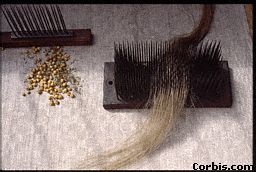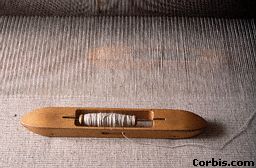|
Links
|
Flax & Linen in Ireland

Flax still is and was usually sowed in early spring and harvested or "pulled"
around three months early for its fibre, when half the seeds are ripe. The
stalks are bound in bundles, which are set in shocks for drying. Later, the
bundles are threshed for the seeds and the straw is "retted" or slightly
rotted in "Flax dams". The process of retting takes about three weeks, after
which the bundles are set again for drying. The dried bundles are crushed
by beetles, which break the stems of the flax into small pieces and
leave behind the springy bark mostly intact. After scutching (crushing and
breaking to remove the fibre from the woody fragments) (see picture above)
the fibre is normallysent to the spinning mill for more processing.
Two types of yarn are produced. One is very fine and used
for high quality linen, lace
and similar material. The rougher kind is largely used in rope making from
different rough fabrics.
Technology in the Linen Industry
In linen production, the technology lagged way behind cotton and woollenfibre
production. It was not until the 1850s, that inventors produced machinesable
to overcome the problems caused by the lack of elasticity in the yarn,which
can break under pressure from power looms. A French man, Philipeede Girard
, those combing machine over came the problem, and performedthe processes
of hecking or separating the long and short fibres. The shortfibres could
be spun into Linen; but the long fibres lacked the strengthuntil Girard improved
their strength by soaking them in hot alkaline solution before the fibrewasprocessed
and spun.

Linen Industry - how it started
Linen manufacturing started off as a cottage industry, and provided manysmall
farmers with a good income. From 1700s on wards the industry was amajor force
in the advance of the economy in the north west of Ulster.
|